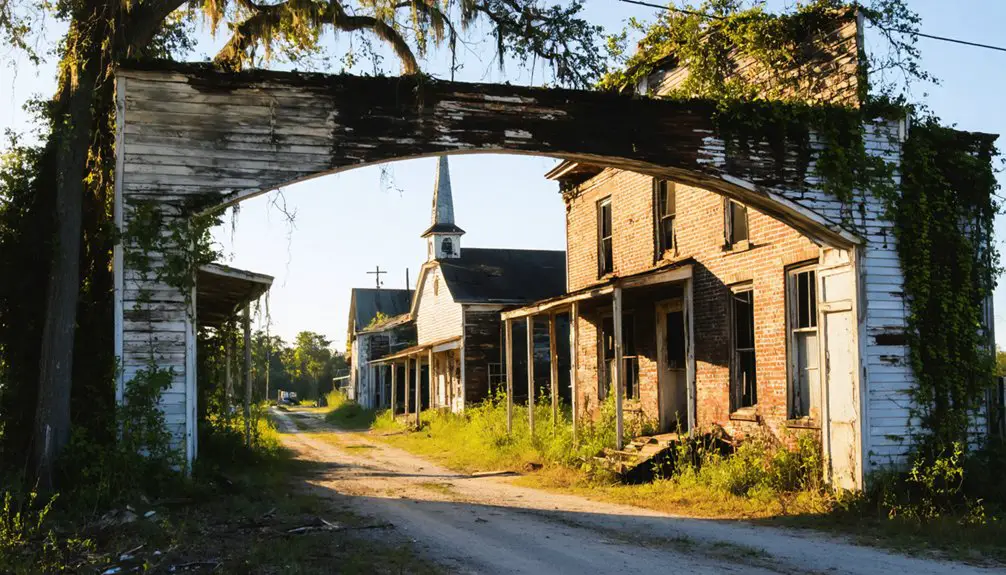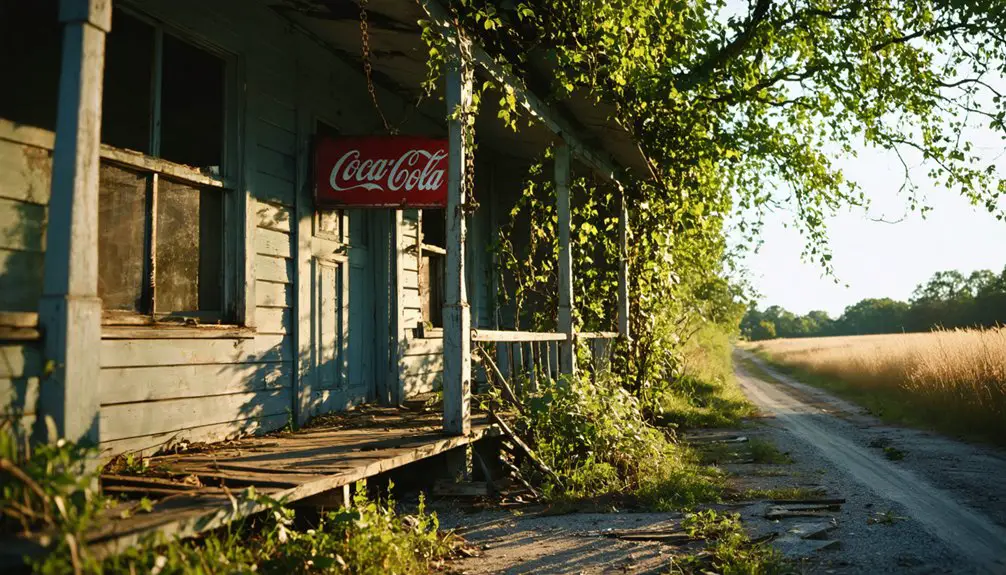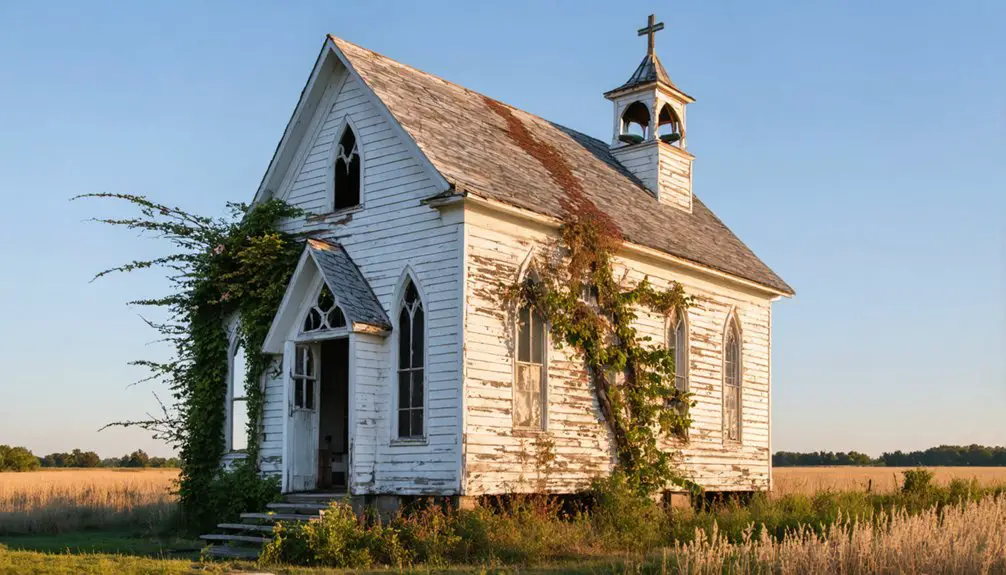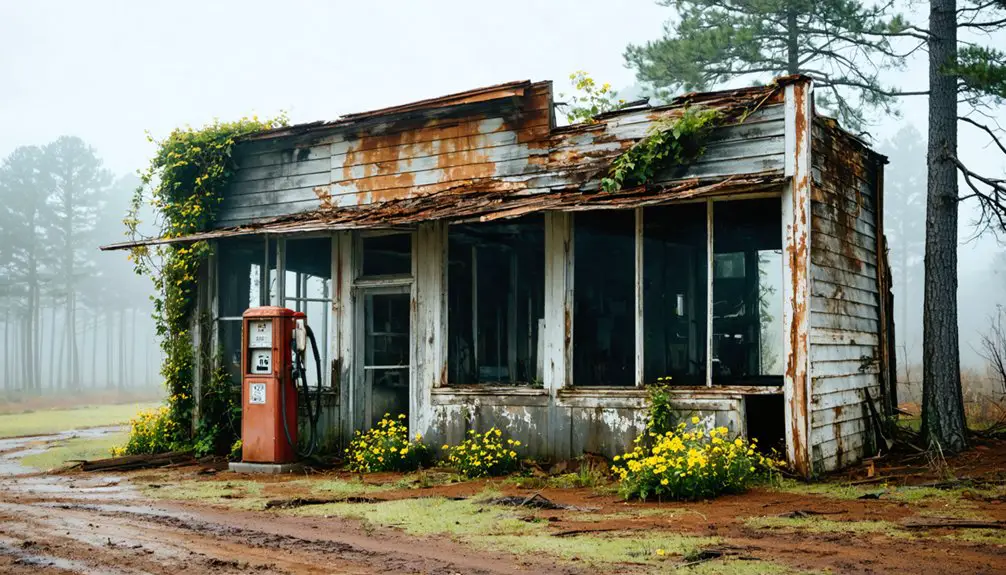You’ll find Colony Town‘s haunting remains in Mississippi’s Delta region at coordinates 33°27’17″N, 90°24’37″W, about 7 miles west of Itta Bena in Leflore County. This former cotton farming community flourished in the late 19th and early 20th centuries before economic shifts and environmental challenges led to its abandonment. Today, scattered foundations, deteriorating barns, and the ruins of a cotton gin tell a compelling story of agricultural heritage and racial justice in the rural South.
Key Takeaways
- Colony Town was an agricultural settlement in Mississippi’s Delta region that relied heavily on cotton production before becoming abandoned.
- The town declined due to economic shifts, health crises including yellow fever, and environmental challenges like flooding and soil depletion.
- Remnants include scattered foundations, deteriorating wooden barns, ruins of a cotton gin, abandoned stables, and worker housing.
- Originally established as Petit Gouffre by French colonists in 1763, it was later renamed Rodney and became a busy Mississippi River port.
- The site represents significant African American history, from slavery through sharecropping to eventual community autonomy during Reconstruction.
Location and Geographic Setting
Colony Town lies in the heart of the Mississippi Delta at coordinates 33°27’17″N, 90°24’37″W, with an elevation of 138 feet above sea level.
This Mississippi Delta ghost town sits quietly at 33°27’17″N, 90°24’37″W, just 138 feet above the fertile floodplain.
You’ll find this ghost town in Leflore County, situated about 7 miles west of Itta Bena and 6 miles east of Moorhead. The town’s geographic features reflect the classic Delta landscape, with flat topography and rich alluvial soil that once supported extensive cotton farming.
The site’s town planning was influenced by its natural surroundings, including seasonal wetlands and meandering creeks that characterize the region. The nearby Muddy Bayou flows approximately 3 miles northwest of the settlement. As a former populated place, Colony Town represents one of the 94 abandoned settlements across Mississippi.
Located near the Sunflower County border, Colony Town’s position offered strategic connections to neighboring communities like Greenwood, Morgan City, and Schlater. The area’s flat terrain and drainage patterns played a significant role in shaping the settlement’s development and eventual decline.
Origins and Early Settlement
Before European settlement transformed the landscape, Native Americans utilized this fertile delta region as an essential travel corridor and settlement area, establishing seasonal camps to take advantage of the abundant hunting, fishing, and gathering opportunities.
These indigenous practices would later influence European settlement patterns along the Mississippi River.
You’ll find the first permanent European presence emerged in 1763 when French colonists established Petit Gouffre, driven by their desire to control river trade.
The settlement changed hands during colonial power struggles, passing from French to British control, and later to Spanish rule in 1781.
Spain’s influence waned by century’s end, culminating in the 1798 sale to Thomas Calvit.
The town was officially renamed Rodney in 1814 to honor Judge Thomas Rodney, marking a new chapter in its development.
The settlement quickly grew into a thriving port city, becoming the busiest Mississippi River port by the 1850s.
Peak Years and Community Life
During its heyday in the late 19th and early 20th centuries, you’d find a bustling rural community shaped by cotton agriculture and stark social divisions. The community dynamics reflected a strict hierarchy: wealthy planters at the top, poor white farmers in the middle, and African American sharecroppers forming the majority at the bottom. Free people of color often migrated away from such communities to seek better opportunities elsewhere.
Much like the early Lenape Indians who established a complex trail system, the town’s residents created an intricate network of paths connecting farms and homesteads.
You’d witness social life revolving around churches and seasonal harvests, with families gathering for festivals after cotton picking ended. While planters’ children received education, most laborers had limited schooling options.
The town’s economy centered on cotton but included general stores, blacksmith shops, and small-scale farming. Simple dirt roads connected wooden churches and cabin-style homes, while railroad access and levee construction helped sustain the community’s agricultural foundation.
Agricultural Heritage and Economy
Like many Mississippi settlements, Colony Town’s agricultural foundation rested heavily on cotton plantations worked by enslaved people before the Civil War, with freed African Americans later becoming landowners and sharecroppers.
Farmers were forced to implement crop rotation methods to combat the severe soil depletion from intensive cotton cultivation.
You’ll find evidence of the community’s attempts to diversify beyond cotton in the late 1800s, though these efforts were hampered by environmental challenges and limited access to credit. Similar to the Jewish agricultural colonies that faced devastating floods in Louisiana, Colony Town’s farming initiatives were frequently disrupted by unpredictable weather patterns.
Despite the introduction of mechanization in the 1930s and 1940s, Colony Town’s agricultural economy couldn’t escape its dependence on exploitative labor practices, contributing to the area’s eventual decline.
Cotton Plantation Legacy
White fields of cotton stretched across Mississippi’s fertile river bottomlands, transforming the region into America’s epicenter of cotton production following the 1793 invention of the cotton gin.
The Natchez District port became central to the expanding cotton trade, serving as a major shipping point along the Mississippi River.
Large plantation operations typically employed skilled enslaved laborers to manage the complex cotton harvesting and processing activities.
You’ll find evidence of this cotton culture in the remnants of gin houses and cotton presses that once processed the region’s white gold.
The plantation economy reshaped the landscape, with thousands of acres cleared for intensive cultivation that ultimately degraded the soil and river systems.
Farm Labor Demographics
As cotton’s dominance waned in Mississippi’s agricultural landscape, the face of farm labor underwent dramatic shifts.
You’ll find that farmworker demographics transformed from a workforce of 300,000 in the 1930s to just 55,000 by 2017, reflecting massive labor shifts tied to mechanization and the Great Migration.
Today’s agricultural workforce presents a complex tapestry. While African Americans maintain a strong presence in central Mississippi’s poultry sector, Latin American immigrants have carved out significant roles in both crop and livestock operations.
You’ll notice stark contrasts in the modern labor force: crop work draws more Hispanic workers and women (28%), while livestock operations employ a higher percentage of non-Hispanic whites (49%).
These changes highlight the evolution from family-based farming, where households averaged 4.4 persons, to today’s diverse, specialized agricultural workforce.
Crop Diversification Attempts
Since colonial times, Mississippi’s agricultural landscape has witnessed numerous attempts at crop diversification, beginning with French settlers‘ efforts to establish tobacco, indigo, and rice cultivation in the early 1700s.
While these early efforts faced challenges from environmental conditions and infrastructure limitations, they laid groundwork for future agricultural innovation.
You’ll find that post-Civil War farmers, particularly African Americans under sharecropping systems, embraced crop rotation and sustainable practices to break free from cotton dependency.
Their cultivation of corn, vegetables, and fruits helped combat soil depletion and provided essential food security.
By the 1900s, the devastating boll weevil infestation forced further diversification, though limited credit access and market instability posed significant hurdles.
Modern Mississippi agriculture has evolved to include commercial blueberry production and advanced sustainable farming methods, marking a significant shift from historical cotton monoculture.
Decline and Abandonment
During the mid-nineteenth century, Colony Town’s fortunes took a dramatic downturn that would ultimately lead to its abandonment.
Economic shifts following the Civil War, particularly the end of slavery, devastated the cotton-based economy that had sustained the community. You’d have seen plantations struggling to maintain profitability while river trade dwindled in importance compared to emerging railroad routes.
Devastating health crises, similar to the yellow fever epidemics that struck nearby Rodney in 1843 and 1847, ravaged the town’s population.
These outbreaks, combined with environmental challenges like flooding and soil depletion, drove residents away. Young people left for urban opportunities, businesses closed, and the remaining population couldn’t sustain basic services.
The town’s inability to modernize its infrastructure sealed its fate, leaving Colony Town to fade into Mississippi’s landscape.
Notable Structures and Landmarks

When you explore Colony Town’s ruins today, you’ll find scattered foundations of the original settlement, including remnants of barns and storage buildings that once supported the area’s agricultural economy.
The remaining structural footprints reveal the town’s farming heritage through deteriorating wooden beams, crumbling stone foundations, and weathered agricultural equipment left behind.
These agricultural remnants, while sparse, provide essential evidence of Colony Town’s once-thriving farming community that depended on the fertile Mississippi Delta soil.
Remnants of Agricultural Buildings
The agricultural backbone of Colony Town lives on through its deteriorating farm structures, offering glimpses into Mississippi’s cotton-farming past.
You’ll find several decaying wooden barns, their post-and-beam frames still standing as prime examples of agricultural archaeology in Leflore County. These structures once housed cotton, hay, and farming equipment essential to the region’s prosperity.
Near the barns, you’ll spot the ruins of a cotton gin, with its brick foundations and scattered machinery parts telling stories of bustling harvest seasons.
The site’s agricultural heritage extends to abandoned stables, livestock pens, and worker housing, all slowly surrendering to Mississippi’s humid climate.
While nature reclaims the old fields and irrigation ditches, these remnants of barn preservation showcase Colony Town’s rich farming legacy.
Original Settlement Foundations
Standing among Colony Town’s architectural remnants, you’ll discover significant foundations that showcase the settlement’s strategic importance in Mississippi’s colonial development.
As you explore the area, you can trace the community development patterns that mirror other historic Mississippi settlements like Fort Rosalie and Fort Maurepas, which served dual purposes as military outposts and trading centers.
The settlement history reflects the dramatic population changes of the Mississippi Territory between 1798 and 1820, when over 222,000 residents transformed the landscape.
Like other towns of its era, Colony Town’s foundations reveal the presence of religious and community structures that served as crucial gathering places.
These architectural footprints tell the story of a community that, similar to Mississippi-in-Africa, represented the complex intersection of freedom, settlement, and cultural identity.
Legacy in Leflore County
Located within Mississippi’s fertile Delta region, Colony Town’s legacy endures through its impact on Leflore County’s demographic and economic evolution.
The town’s rise and fall mirrors broader cultural heritage patterns that shaped the region, from its cotton-based economy to the Great Migration that transformed local communities.
You’ll find Colony Town’s influence reflected in these enduring aspects of Leflore County:
- A testament to African American resilience, as former residents joined the mass exodus northward seeking better opportunities
- Part of the county’s shift from river-based commerce to railroad transportation, affecting settlement patterns
- A reminder of the region’s agricultural heritage, where cotton production once dominated the economic landscape
Today, while Colony Town stands abandoned, its story represents the profound changes that reshaped Mississippi’s Delta region throughout the 20th century.
Historical Significance Today
As modern historians explore Colony Town‘s abandoned streets, its significance grows ever more profound in today’s conversations about racial justice and land ownership.
You’ll find its story woven into historical narratives that highlight African American agency during Reconstruction, showcasing how formerly enslaved people built thriving, self-sufficient communities despite overwhelming odds.
Today, Colony Town serves as a powerful symbol of Black resilience in the rural South.
Through cultural celebrations and educational events, you’re invited to witness how this remarkable settlement challenged racial discrimination through land ownership and community solidarity.
The town’s legacy continues to inform discussions about reparative history and inspires contemporary movements for racial land justice, reminding you that the struggle for autonomy and dignity remains relevant in modern America.
Visiting Colony Town
Deep in the heart of Leflore County, Mississippi, Colony Town beckons history enthusiasts and curious travelers to explore its abandoned streets.
You’ll find this ghost town about 7 miles west of Itta Bena and 6 miles east of Moorhead, making it an ideal spot for rural photography and quiet exploration at 138 feet above sea level.
When planning your visit, keep in mind:
- Bring essential supplies, as there are no services within Colony Town
- Use daylight hours for the best ghost town exploration experience
- Navigate using GPS coordinates (33°27′17″N 90°24′37″W) for accurate location
While Colony Town itself is stripped of amenities, you’ll find food and lodging in nearby Itta Bena or Moorhead.
The surrounding Delta region offers additional cultural attractions, including Mississippi Valley State University and Rice-Totten Stadium.
Frequently Asked Questions
What Local Legends or Ghost Stories Are Associated With Colony Town?
You won’t find documented haunted whispers or spectral sightings here, as historical records and local folklore remain mysteriously quiet about this settlement, unlike Mississippi’s other ghost towns with established paranormal tales.
Were There Any Famous Residents or Visitors to Colony Town?
You won’t find records of famous visitors or historical residents specifically tied to Colony Town, though nearby Rodney attracted wealthy planters and politicians during Mississippi’s early territorial period.
What Natural Disasters Have Affected Colony Town Throughout Its History?
Like a relentless hammer, natural disasters pummeled your region through the Great Mississippi Flood of 1927’s devastating flood damage and Hurricane Katrina’s catastrophic impacts in 2005, bringing 20-foot storm surges.
Which Families Were the Last to Leave Colony Town?
You won’t find records naming the last families who left, as historical documents don’t track the departure timeline. Local archives and county records haven’t preserved details of final residents.
Are There Any Remaining Grave Sites or Cemeteries Near Colony Town?
While over 80% of Mississippi ghost towns have lost burial records, you’ll find no documented grave site locations near Colony Town. Local cemetery history suggests burials likely exist but remain unmarked or undiscovered.
References
- https://www.abandonedspaces.com/towns/rodney-mississippi-the-ghost-town-that-once-was-meant-to-be-the-capital-of-the-state-of-mississippi.html
- https://www.youtube.com/watch?v=aRtDvlY8268
- https://mississippifolklife.org/articles/haunted-by-a-ghost-town-the-lure-of-rodney-mississippi
- https://en-academic.com/dic.nsf/enwiki/11563952
- https://en.wikipedia.org/wiki/Colony_Town
- https://mapcarta.com/21190512
- https://www.famousfix.com/topic/colony-town-mississippi
- https://www.wikiwand.com/en/map/Colony_Town
- https://en.wikipedia.org/wiki/History_of_Mississippi
- https://digging-history.com/category/ghost-town-wednesday/page/9/



